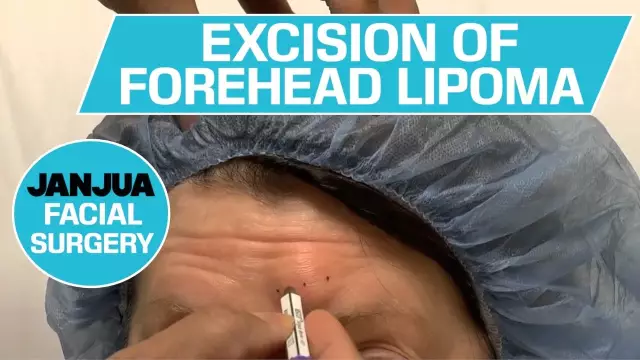- Author Rachel Wainwright [email protected].
- Public 2023-12-15 07:39.
- Last modified 2025-11-02 20:14.
Lipoma on the back

Lipoma is a benign tumor of adipose tissue. Outwardly, it represents a mobile and soft fatty formation located under the skin. A lipoma can form almost anywhere, but the most common lipoma is on the back. The neoplasm does not affect nearby organs, but only expands the tissue as it grows. The tumor is separated from the surrounding tissue by means of a capsule, in which, in fact, it is located.
Causes of the appearance of a lipoma on the back
The exact cause of the tumor is unknown. It is believed that lipoma on the back and other parts of the body occurs as a result of metabolic disturbances in the body, during which the sebaceous ducts are blocked. In addition, there are a number of factors that predispose to the formation of a lipoma on the back:
- wrong lifestyle;
- malnutrition;
- constant mechanical irritation;
- poor ecology in the place of residence.
So, you can often find a lipoma on the back of porters and porters. It arises due to the specifics of their work.
Women aged 30-50 are more prone to the appearance of lipomas. The size of a lipoma can vary from a small pea to the size of a baby's head.
Lipoma symptoms on the back
Most of the tumor has no pronounced symptoms, but in some people it causes severe pain. This is due to the fact that in the process of enlargement, the tumor presses on nearby organs and nerve endings.
A pea-sized lipoma on the back can be accidentally discovered by the patient himself or other people when massaging or feeling the back. The lipoma is elastic and soft to the touch, easily displaceable, painless. As a rule, it has a clear oval or round shape. With intramuscular lipoma, clear boundaries may be absent. The skin on the lipoma has the same color as everywhere else.
Lipoma diagnostics

Correct diagnosis of lipoma presents certain difficulties.
For an accurate diagnosis, the patient is sent for X-ray diagnostics, histological examination, ultrasound examination and computed tomography.
Back lipoma treatment
As a rule, with an asymptomatic course of the tumor, they prefer not to treat it at all. Treatment is performed if the lipoma gives the patient cosmetic or other inconveniences, or rapidly increases in size.
Drug treatment for lipoma is ineffective. In addition, it is categorically not recommended for patients to independently treat or remove a lipoma on the back, since often a malignant tumor can be mistaken for a lipoma. If you use all kinds of compresses and ointments for treatment, this can only lead to an increase in the tumor. Lipomas cannot be opened and picked out on their own, as this is fraught with infection. In large lipomas, a failure occurs in the process of tissue nutrition, which contributes to the erosion of blood vessels, the appearance of ulcers on the skin, and putrefactive decay.
The only acceptable treatment for lipoma is surgical removal of the lipoma on the back or laser therapy. Today, laser therapy is the most gentle and effective method of treating lipomas on the face, legs, arms and other parts of the body. As a rule, there is no relapse after laser therapy. After laser treatment, the wound heals quite quickly, leaving no scars or scars. Therefore, laser therapy is the most viable option.
Lipoma removal on the back is performed by liposuction. The fat is sucked out through small incisions with a diameter of 0.3-0.5 cm. For this, a special vacuum is used. It is believed that this method of removing lipomas on the back is the easiest. In addition, after such an operation, there are practically no traces.
YouTube video related to the article:
The information is generalized and provided for informational purposes only. At the first sign of illness, see your doctor. Self-medication is hazardous to health!






